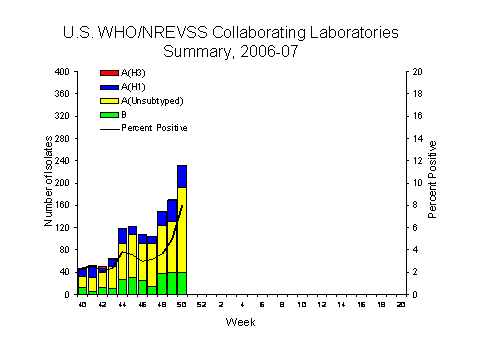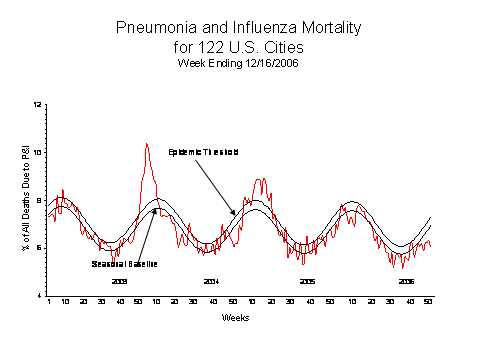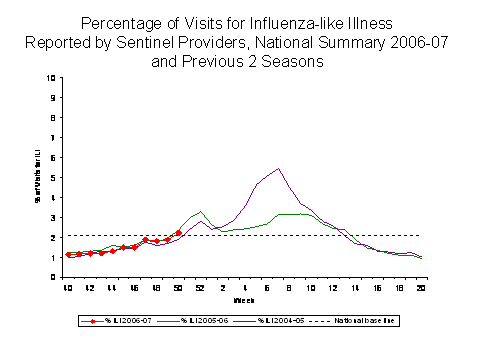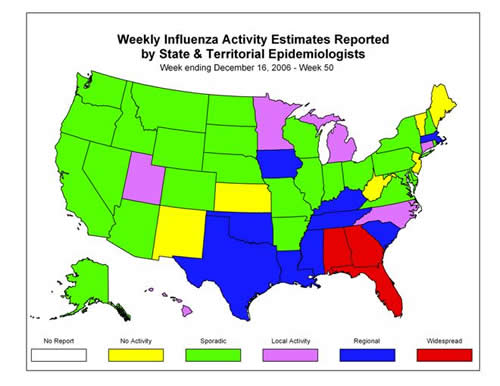Error processing SSI file
Error processing SSI file
Weekly Report: Influenza Summary Update
Week ending December 16, 2006-Week 50
Error processing SSI fileSynopsis:
During week 50 (December 10 ?December 16, 2006)*, influenza activity increased in the United States. Among specimens tested by U.S. World Health Organization (WHO) and National Respiratory and Enteric Virus Surveillance System (NREVSS) collaborating laboratories for influenza, 8.0% were positive. Three states reported widespread influenza activity; nine states reported regional influenza activity; six states reported local influenza activity; 26 states, the District of Columbia, and New York City reported sporadic influenza activity; and six states reported no influenza activity. The reporting of reporting widespread or regional influenza activity increased from four states for week 49 to 12 states for week 50. On a national level, laboratory and outpatient influenza-like illness (ILI) surveillance data indicated an increase from week 49 to week 50, and ILI was above its baseline for the first time this season. However, the percent of deaths due to pneumonia and influenza remained below baseline level.
Laboratory Surveillance*:
During week 50, WHO and NREVSS laboratories reported 2,909 specimens tested for influenza viruses, 232 (8.0%) of which were positive: 39 influenza A (H1) viruses, one influenza A (H3), 152 influenza A viruses that were not subtyped, and 40 influenza B viruses.
Since October 1, 2006, WHO and NREVSS laboratories have tested a total of 33,030 specimens for influenza viruses and 1,218 (3.7%) were positive. Among the 1,218 influenza viruses, 962 (79%) were influenza A viruses and 256 (21%) were influenza B viruses. Two hundred thirty-four (24%) of the 962 influenza A viruses have been subtyped: 222 (95%) were influenza A (H1) viruses and 12 (5%) were influenza A (H3) viruses. Of the 1,218 influenza positive tests reported this season, 503 (41%) have been reported from Florida.

View Chart Data | View Full Screen
Antigenic Characterization:
CDC has antigenically characterized 42 influenza viruses [10 influenza A (H1), one influenza A (H3), and 31 influenza B viruses] collected by U.S. laboratories since October 1, 2006.
Influenza A (H1)[10]It is too early in the influenza season to determine which influenza viruses will predominate or how well the vaccine and circulating strains will match.?Eight of the 10 viruses were characterized as A/New Caledonia/20/99-like, which is the influenza A (H1) component of the 2006-07 influenza vaccine.Influenza A (H3)
?Two of the 10 viruses showed somewhat reduced titers with antisera produced against A/New Caledonia/20/99.
?The virus was characterized as A/Wisconsin/67/2005-like, which is the influenza A (H3) component of the 2006-07 influenza vaccine.Influenza B (B/Victoria/02/87 and B/Yamagata/16/88 lineages)[31]Victoria lineage [18]
?Eighteen (58%) of the 31 influenza B viruses characterized belong to the B/Victoria lineage of viruses.o Seven of these 18 viruses were similar to B/Ohio/01/2005, the B component of the 2006-07 influenza vaccine.Yamagata lineage [13]
o Eleven of these 18 viruses showed somewhat reduced titers with antisera produced against B/Ohio/01/2005.
?Thirteen (42%) of the 31 influenza B viruses characterized belong to the B/Yamagata lineage of viruses.
Pneumonia and Influenza (P&I) Mortality Surveillance*:
During week 50, 6.1% of all deaths were reported as due to pneumonia or influenza. This percentage is below the epidemic threshold of 7.3% for week 50.

Influenza-Associated Pediatric Mortality*:
No influenza-associated pediatric deaths were reported for week 50, and no deaths have been reported for the 2006-07 influenza season.
Influenza-Associated Pediatric Hospitalizations*:
Laboratory-confirmed influenza-associated pediatric hospitalizations are monitored in two population-based surveillance networks?/sup>: the Emerging Infections Program (EIP) and the New Vaccine Surveillance Network (NVSN). No influenza-associated pediatric hospitalizations have been reported from either network this season.
Influenza-like Illness Surveillance*:
During week 50, 2.2%*** of patient visits to U.S. sentinel providers were due to ILI. This percentage is above the national baseline**** of 2.1%. On a regional level**, the percentage of visits for ILI ranged from 1.0% to 5.0%. Four regions reported ILI above their region-specific baseline****: the New England region reported 1.3% compared to its baseline of 1.2%, the South Atlantic region reported 2.5% compared to its baseline of 2.3%, the East South Central region reported 5.0% compared to its baseline of 2.4%, and the West South Central region reported 4.1% compared to its baseline of 3.0%.

View
Chart Data
| View Full Screen
Influenza Activity as Assessed by State and Territorial Epidemiologists*:
During week 50, the following influenza activity唵 was reported:
?Widespread activity was reported by three states (Alabama, Florida, and Georgia).
?Regional activity was reported by nine states (Iowa, Kentucky, Louisiana, Massachusetts, Mississippi, Oklahoma, South Carolina, Tennessee, and Texas).
?Local activity was reported by six states (Connecticut, Hawaii, Michigan, Minnesota, North Carolina, and Utah).
?Sporadic activity was reported by the District of Columbia, New York City and 26 states (Alaska, Arizona, Arkansas, California, Colorado, Delaware, Idaho, Illinois, Indiana, Maryland, Missouri, Montana, Nebraska, New Hampshire, Nevada, New York, North Dakota, Ohio, Oregon, Pennsylvania, Rhode Island, South Dakota, Virginia, Washington, Wisconsin, and Wyoming).
?No influenza activity was reported by six states (Kansas, Maine, New Jersey, New Mexico, Vermont, and West Virginia).
--------------------------------------------------------------------------------
Report prepared December 22, 2006
Error processing SSI file